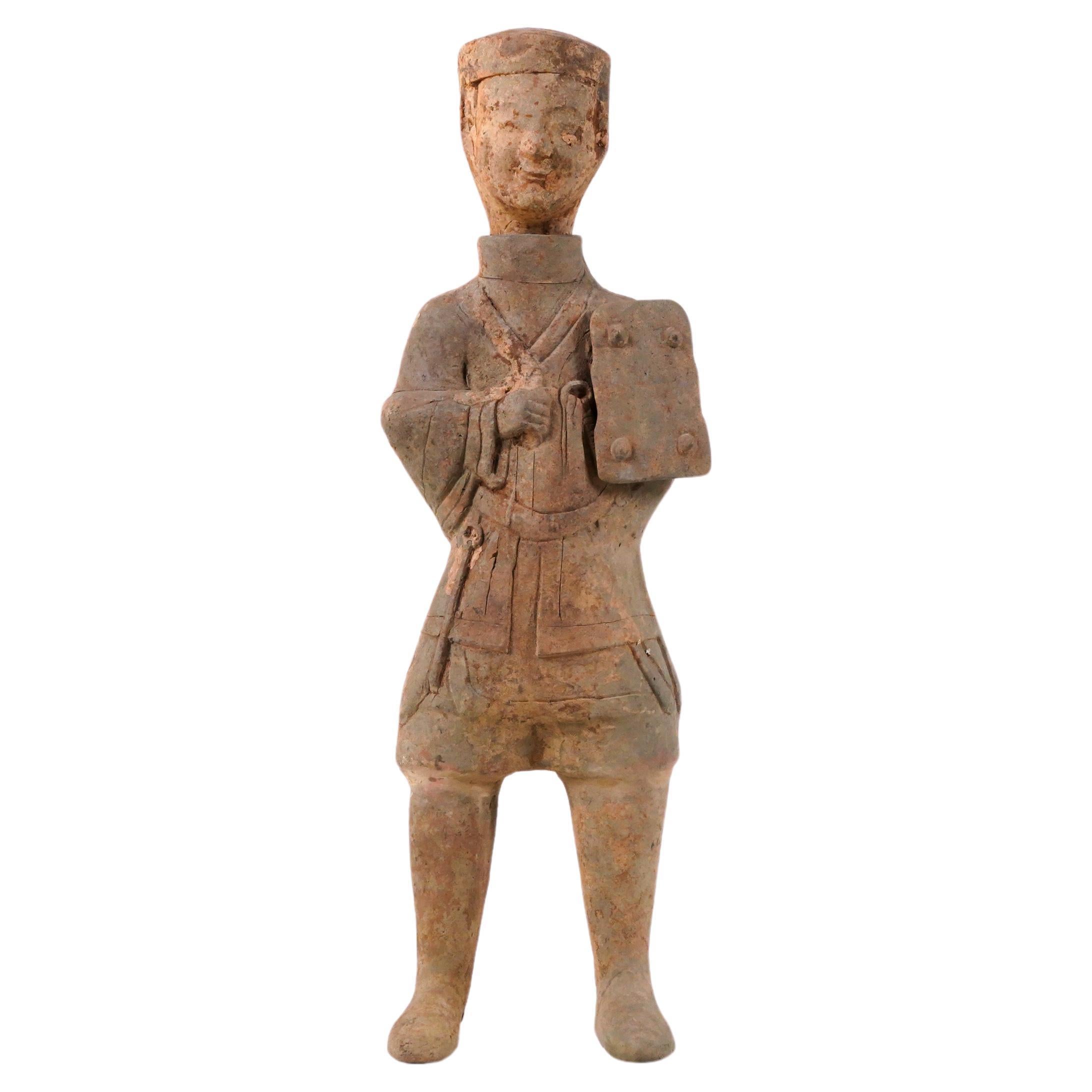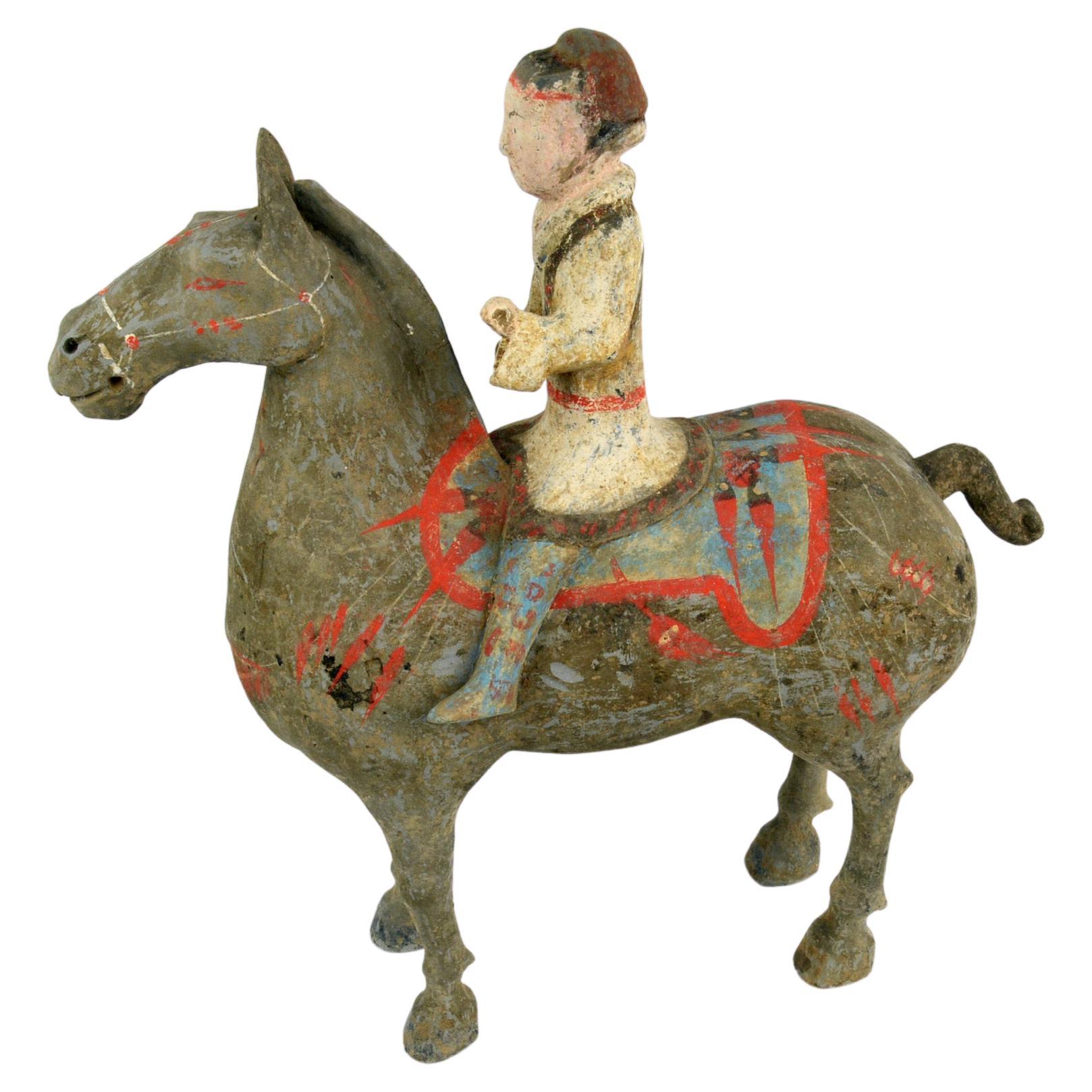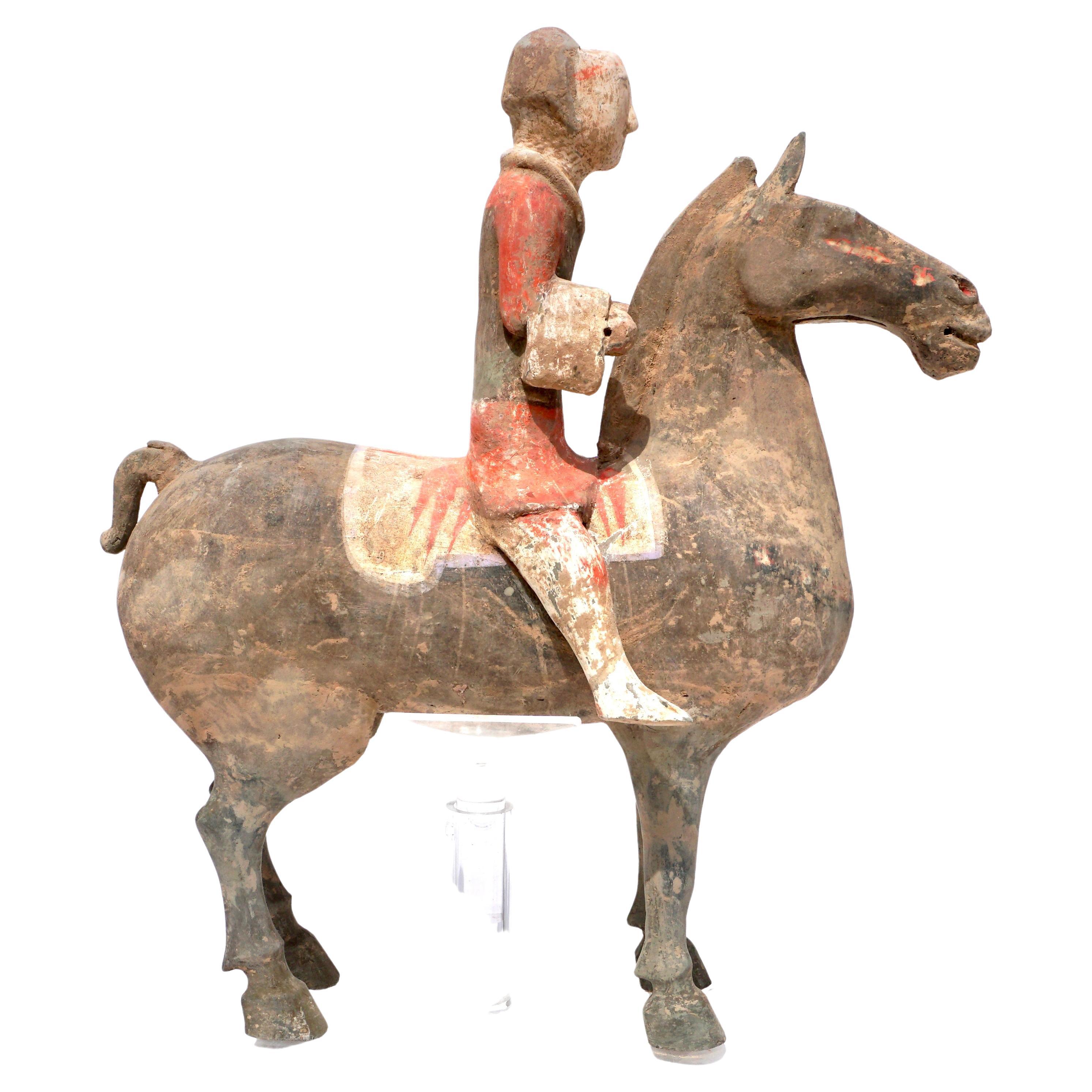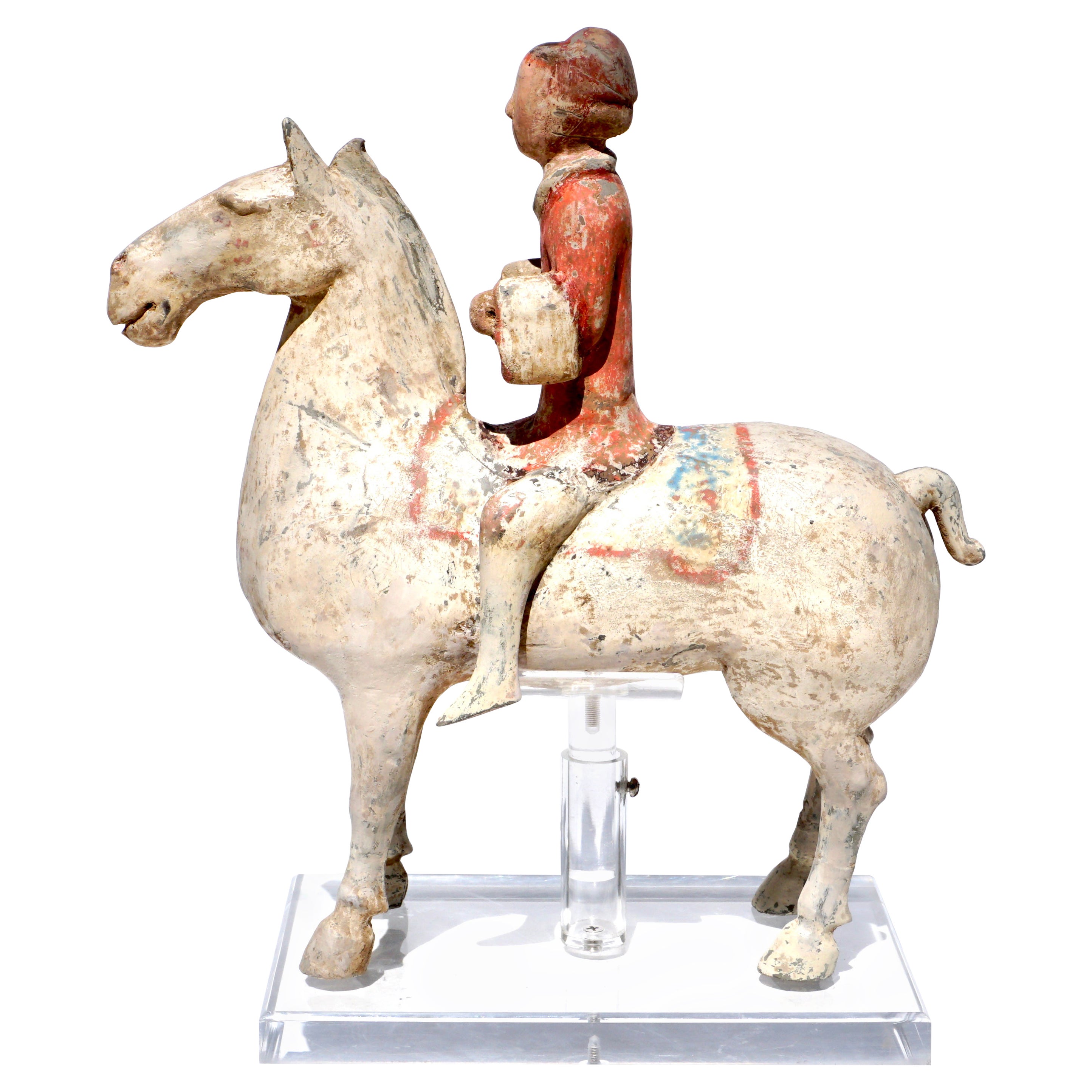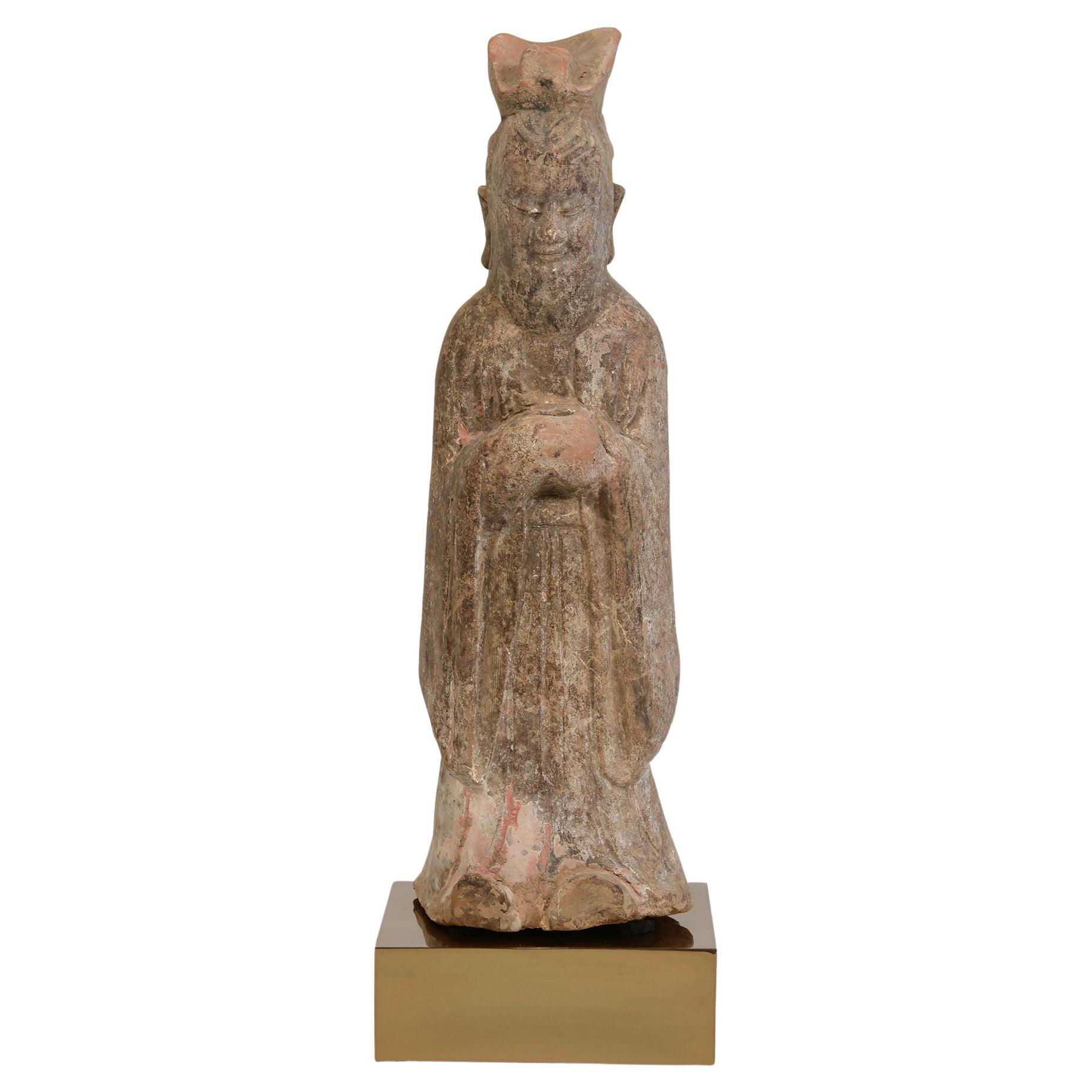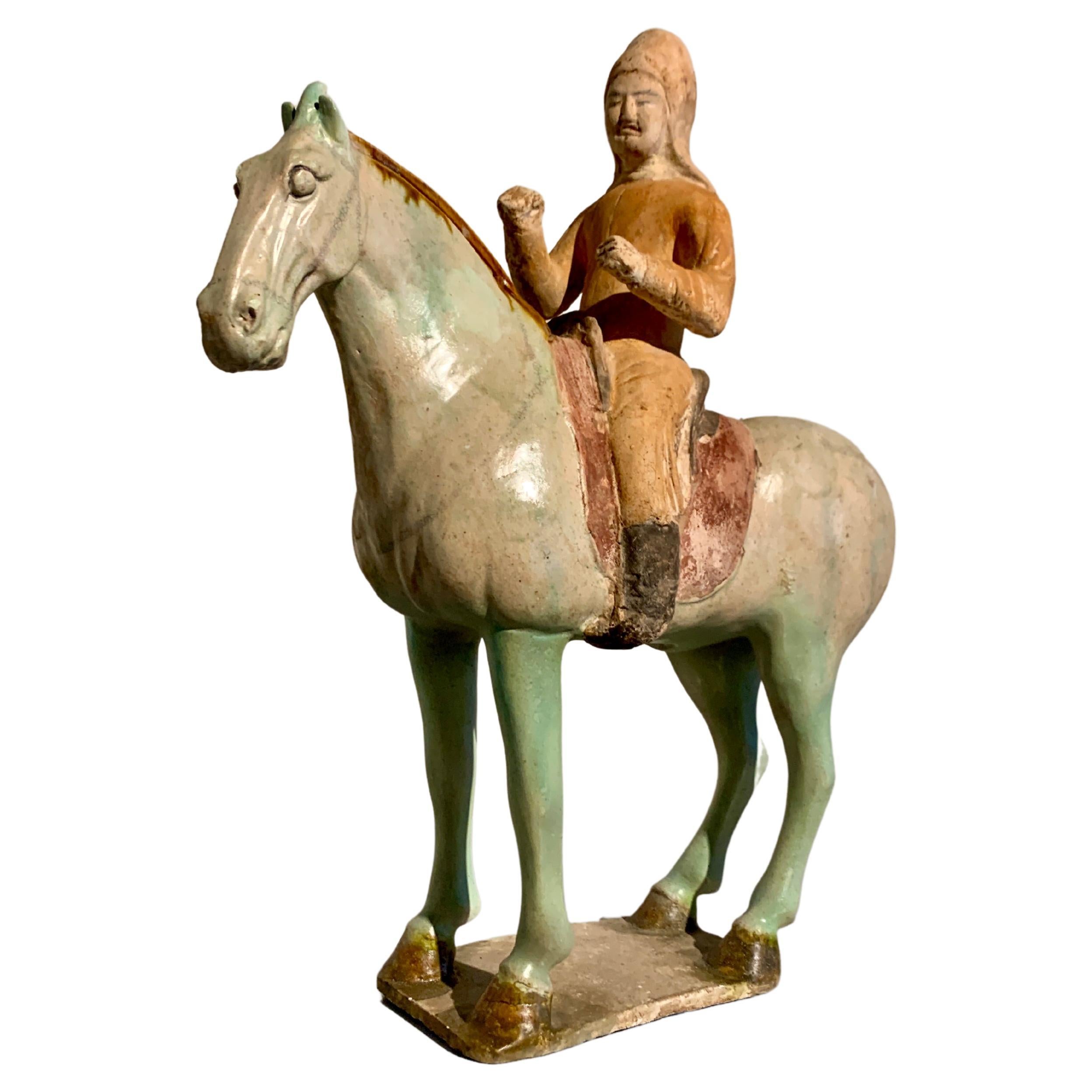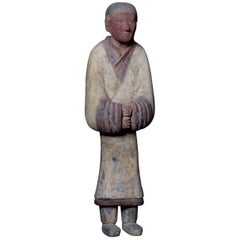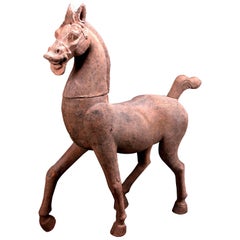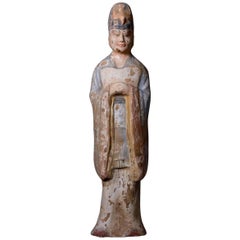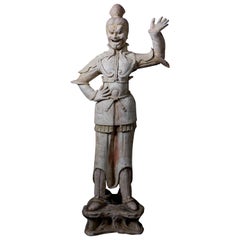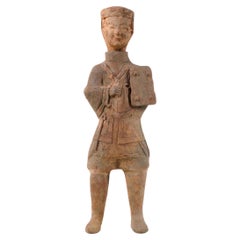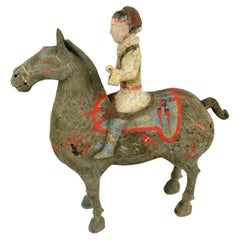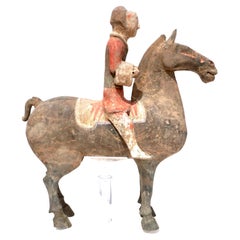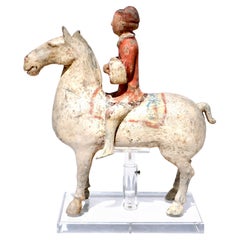Items Similar to Han Dynasty Standing Horse Trainer “Palafrenieri”
Want more images or videos?
Request additional images or videos from the seller
1 of 11
Han Dynasty Standing Horse Trainer “Palafrenieri”
$23,125
£17,680.29
€20,364.13
CA$32,405.22
A$36,177.38
CHF 18,956.40
MX$442,846.59
NOK 240,746.48
SEK 226,993.36
DKK 151,979.57
About the Item
Huge hollow molded terracotta, standing male figure wearing a hip-length multi-layered robe with a collared neck. Implements suspended from his waist, holding a staff in his right hand and wearing a disc type cap. Some earthen encrustation on surface with traces of red and white painted pigments. Professionally repaired from several original pieces with restoration over the break lines.Han Dynasty, China. 206 BCE-220 CE. Custom metal base. Private Florida collection, purchased in England in mid 1980s.
- Dimensions:Height: 35 in (88.9 cm)Width: 12 in (30.48 cm)Depth: 8 in (20.32 cm)
- Style:Han (Of the Period)
- Materials and Techniques:
- Period:
- Date of Manufacture:206BC - 220AD
- Condition:
- Seller Location:San Pedro Garza Garcia, MX
- Reference Number:Seller: CH-0871stDibs: LU317239483521
About the Seller
3.7
Vetted Professional Seller
Every seller passes strict standards for authenticity and reliability
1stDibs seller since 2017
24 sales on 1stDibs
Typical response time: 1 to 2 days
- ShippingRetrieving quote...Shipping from: San Pedro Garza Garcia, Mexico
- Return Policy
Authenticity Guarantee
In the unlikely event there’s an issue with an item’s authenticity, contact us within 1 year for a full refund. DetailsMoney-Back Guarantee
If your item is not as described, is damaged in transit, or does not arrive, contact us within 7 days for a full refund. Details24-Hour Cancellation
You have a 24-hour grace period in which to reconsider your purchase, with no questions asked.Vetted Professional Sellers
Our world-class sellers must adhere to strict standards for service and quality, maintaining the integrity of our listings.Price-Match Guarantee
If you find that a seller listed the same item for a lower price elsewhere, we’ll match it.Trusted Global Delivery
Our best-in-class carrier network provides specialized shipping options worldwide, including custom delivery.More From This Seller
View AllElegant Han Dynasty Terracotta Warrior - China '206 BC - 220 AD'
Located in San Pedro Garza Garcia, Nuevo Leon
Impressive terracotta warrior representing a banner bearer gripping a wooden staff with his hands (dematerialized through the ages); his gaze is ser...
Category
Antique 15th Century and Earlier Chinese Han Antiquities
Materials
Terracotta
Monumental Han Dynasty Terracotta Horse - TL Tested - China, '206 BC–220 AD'
Located in San Pedro Garza Garcia, Nuevo Leon
A massive pottery horse with separately made head and tail, standing on all fours and striding with its right hoof forward. Extended snout ends in parted lips showing teeth beneath i...
Category
Antique 15th Century and Earlier Chinese Han Antiquities
Materials
Terracotta
Elegant Terracotta Standing Court Dignitary, Tang Dynasty, EU Passport
Located in San Pedro Garza Garcia, Nuevo Leon
Elegant Standing Court Dignitary with joined hands in blue robes and a bird headdress. Polychrome Traces.
When China was unified again, first briefly ...
Category
Antique 15th Century and Earlier Chinese Tang Antiquities
Materials
Terracotta
Tang Dynasty Imposing Terracota Lokapala Standing in Menacing Pose - TL Tested
Located in San Pedro Garza Garcia, Nuevo Leon
Imposing Lokapala figure standing in menacing pose. Terracotta with traces of old color pigments. China, Tang dynasty (618-907 AD.) Museum piece.
Lokapalas according to the Buddhist...
Category
Antique 15th Century and Earlier Tang Antiquities
Stunning Terracotta Standing Horse, Tang Dynasty, China '618-907 AD', TL Test
Located in San Pedro Garza Garcia, Nuevo Leon
Magnificent standing horse in orange terracotta and traces of painting. With a finely decorated saddle and with the mane and tail hair braided. TL Test by Ralph Kotalla Lab NE: 09K12...
Category
Antique 15th Century and Earlier Chinese Tang Antiquities
Materials
Terracotta
Very Elegant Tang Dynasty Dignitary in Orange Terracotta, China '618-907 AD'
Located in San Pedro Garza Garcia, Nuevo Leon
Very elegant terracotta dignitary in blue and red robes standing with the hands joined at the chest. He wears a blue headdress with a bird at its center. Orange Terracotta
This gorg...
Category
Antique 15th Century and Earlier Chinese Tang Antiquities
Materials
Terracotta
You May Also Like
A Han Dynasty Terracotta Figure
Located in Chicago, IL
A large Chinese terracotta tomb figure (Ni Yong) from the Eastern Han Dynasty (25-220 AD), likely from the area of modern-day Sichuan. It appears to depict a groom in full costume an...
Category
Antique 15th Century and Earlier Chinese Antiquities
Materials
Terracotta
$12,600 Sale Price
30% Off
Han Dynasty Horse and Rider
Located in Santa Monica, CA
Han Equestrian
This equestrian represents the standard of Western Han equestrian found in Yang Jiawan of Xian. The technique of making includes molding, engraving and cold painting....
Category
Antique 15th Century and Earlier Chinese Han Sculptures and Carvings
Materials
Pottery
Han Dynasty Polychromed Horse and Rider
Located in Dallas, TX
A fine Han dynasty polychrome painted terracotta horse and rider. The warrior is dressed in orange and black on a black horse.
Measures: Height 14 inches (35 cm)
Width 12.5 inches (32 cm).
Condition: Excellent with tastefully undetectable repairs.
During the unification of China under the Han dynasty, bands of mounted nomadic warriors from the north threatened the country. In order to thwart their attacks, the Chinese sought to import stronger, faster steeds from Central Asia (as opposed to the Mongol ponies used by the invaders), eventually leading to the creation of the Silk Road. This small sculpture of a mounted soldier reveals the crucial military role of the horse. When compared to the diminutive stature of the rider, the importance of the horse becomes readily apparent. This creature provided security and strength, allowing the empire to secure its borders and expand its influences across Central Asia. The magnificent regalia of the horse, including a brilliantly painted saddle in red and green/gold, reflect the respect this animal received. The warrior as well is gorgeously decorated with a painted red tunic and gray chest...
Category
Antique 15th Century and Earlier Chinese Han Figurative Sculptures
Materials
Terracotta
Han Dynasty Pottery Horse and Rider
Located in Dallas, TX
Han Dynasty painted pottery horse and rider
A Chinese Han Dynasty painted pottery horse & rider. Made from grey pottery and cold-painted in white, red and black pigments. The rider dressed as a warrior and in the pose of holding reins for the horse. Comes with a custom sturdy lucite stand.
Measures: Height: 13.5 inches (33cm).
Length: 13 inches
Depth: 5 inches
Han Dynasty (206 BC – AD 220).
Condition: Very good with past restoration to legs.
The great influence of the horse throughout the history of China can...
Category
Antique 15th Century and Earlier Chinese Han Animal Sculptures
Materials
Pottery
Northern Qi Dynasty, Antique Chinese Pottery Standing Court Man
Located in Sampantawong, TH
Antique Chinese pottery standing court man.
Age: China, Northern Qi Dynasty, A.D. 550 - 577
Size of figure only: Height 29.8 C.M. / Width 9 C.M.
Height including stand: 33.8 C.M.
Co...
Category
Antique 15th Century and Earlier Chinese Antiquities
Materials
Pottery
$1,480 Sale Price
20% Off
Chinese Tang Dynasty Sancai Glazed Horse and Rider, TL Tested, China
Located in Austin, TX
A fine and unusual Chinese Tang Sancai glazed model of a horse and rider, Tang Dynasty (618 to 906 CE), early 8th century, China.
This fantastic sculpture portrays a male figures se...
Category
Antique 15th Century and Earlier Chinese Tang Antiquities
Materials
Earthenware, Pottery
More Ways To Browse
Train Furniture
Antique Trains
Asian Horse Art
Antique Metal Train
Antique Metal Horse
Dynasty Horse
Metal Horse Mid Century
Han Horse
Terracotta Horse
Chinese Red Horse
Chinese Disc
Han Dynasty Figure
Horse Collar
Antique Terracotta Horse
Chinese Horse Terracotta
Han Dynasty Horse
Han Dynasty Terracotta Figure
Antique Horse Collars
